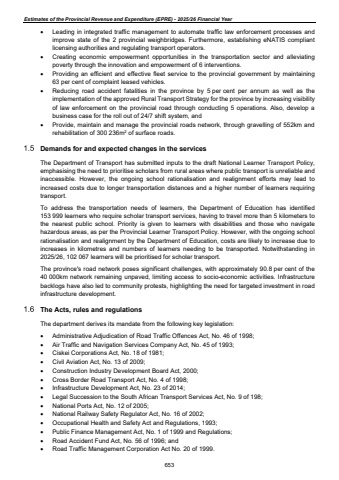Page 674 - Demo
P. 674
Estimates of the Provincial Revenue and Expenditure (EPRE) - 2025/26 Financial Year%uf0b7 Leading in integrated traffic management to automate traffic law enforcement processes and improve state of the 2 provincial weighbridges. Furthermore, establishing eNATIS compliant licensing authorities and regulating transport operators. %uf0b7 Creating economic empowerment opportunities in the transportation sector and alleviating poverty through the innovation and empowerment of 6 interventions. %uf0b7 Providing an efficient and effective fleet service to the provincial government by maintaining 63 per cent of complaint leased vehicles. %uf0b7 Reducing road accident fatalities in the province by 5 per cent per annum as well as the implementation of the approved Rural Transport Strategy for the province by increasing visibility of law enforcement on the provincial road through conducting 5 operations. Also, develop a business case for the roll out of 24/7 shift system, and %uf0b7 Provide, maintain and manage the provincial roads network, through gravelling of 552km and rehabilitation of 300 236m2 of surface roads. Demands for and expected changes in the services The Department of Transport has submitted inputs to the draft National Learner Transport Policy, emphasising the need to prioritise scholars from rural areas where public transport is unreliable and inaccessible. However, the ongoing school rationalisation and realignment efforts may lead to increased costs due to longer transportation distances and a higher number of learners requiring transport. To address the transportation needs of learners, the Department of Education has identified 153 999 learners who require scholar transport services, having to travel more than 5 kilometers to the nearest public school. Priority is given to learners with disabilities and those who navigate hazardous areas, as per the Provincial Learner Transport Policy. However, with the ongoing school rationalisation and realignment by the Department of Education, costs are likely to increase due to increases in kilometres and numbers of learners needing to be transported. Notwithstanding in 2025/26, 102 067 learners will be prioritised for scholar transport. The province's road network poses significant challenges, with approximately 90.8 per cent of the 40 000km network remaining unpaved, limiting access to socio-economic activities. Infrastructure backlogs have also led to community protests, highlighting the need for targeted investment in road infrastructure development. The Acts, rules and regulations The department derives its mandate from the following key legislation: %uf0b7 Administrative Adjudication of Road Traffic Offences Act, No. 46 of 1998; %uf0b7 Air Traffic and Navigation Services Company Act, No. 45 of 1993; %uf0b7 Ciskei Corporations Act, No. 18 of 1981; %uf0b7 Civil Aviation Act, No. 13 of 2009; %uf0b7 Construction Industry Development Board Act, 2000; %uf0b7 Cross Border Road Transport Act, No. 4 of 1998; %uf0b7 Infrastructure Development Act, No. 23 of 2014; %uf0b7 Legal Succession to the South African Transport Services Act, No. 9 of 198; %uf0b7 National Ports Act, No. 12 of 2005; %uf0b7 National Railway Safety Regulator Act, No. 16 of 2002; %uf0b7 Occupational Health and Safety Act and Regulations, 1993; %uf0b7 Public Finance Management Act, No. 1 of 1999 and Regulations; %uf0b7 Road Accident Fund Act, No. 56 of 1996; and %uf0b7 Road Traffic Management Corporation Act No. 20 of 1999. 653


